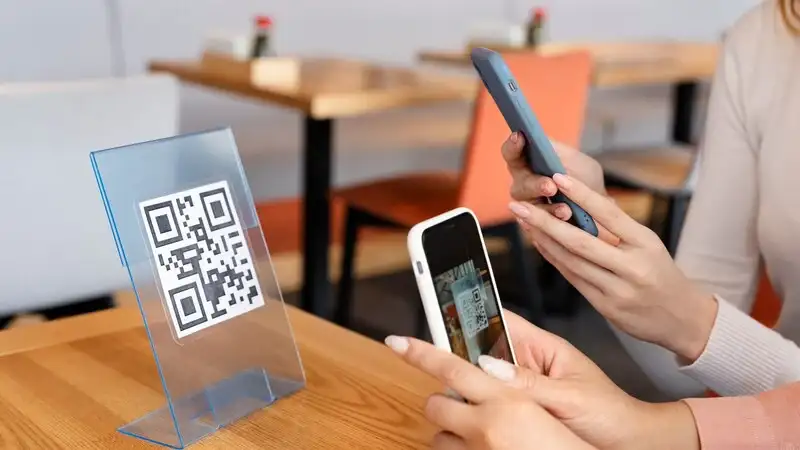In an increasingly digital world, quick and efficient access”qr code” to information has become a cornerstone of modern technology. Among the innovations that have significantly contributed to this is the QR code, short for “Quick Response” code. These two-dimensional barcodes, characterized by their distinctive square grid patterns, have revolutionized how we share and access data. From marketing and payments to health care and logistics, QR codes have woven themselves into the fabric of contemporary life.

What is a QR Code?
A QR code is a type of barcode that can store a wide variety of data, such as URLs, text, or contact information. Unlike traditional barcodes that store data in a linear fashion, QR codes store data in a matrix format, allowing them to hold much more information. This data can be scanned and decoded using devices like smartphones, tablets, and dedicated barcode scanners.
Originally developed in 1994 by the Japanese company Denso Wave, QR codes were designed to improve inventory tracking in the automotive industry. Over time, their utility expanded to other sectors due to their ability to encode large amounts of information in a compact and scannable format.
How QR Codes Work
QR codes work by encoding data into a pattern of black and white squares. When scanned by a compatible device, such as a smartphone camera or a QR code reader, the encoded information is decoded and displayed to the user. Here’s a step-by-step breakdown:
- Data Encoding: The data is converted into a binary format and arranged in a matrix of squares. This data can include alphanumeric characters, numeric codes, or binary symbols.
- Scanning: The device’s camera captures the QR code image and sends it to software that interprets the code.
- Decoding: The software reads the data encoded in the grid pattern and converts it into usable information, such as opening a website or displaying text.
QR codes are equipped with error correction capabilities, meaning they can still be scanned successfully even if a portion of the code is damaged or obscured. This resilience has further contributed to their widespread adoption.
Applications of QR Codes
QR codes have transcended their original purpose of finding applications across a range of industries. Below are some key areas where QR codes are making an impact:
1. Marketing and Advertising
Marketers have embraced QR codes as a tool to engage consumers. By embedding QR codes in advertisements, flyers, or product packaging, companies can direct customers to promotional websites, video tutorials, or downloadable apps. This seamless integration of offline and online marketing helps businesses bridge the gap between physical and digital engagement.
2. Retail and Payments
In retail, QR codes simplify payment processes. Mobile payment platforms like Apple Pay, Google Pay, and Paytm leverage QR codes to facilitate quick and secure transactions. Customers can scan a QR code at checkout to pay directly from their bank account or digital wallet, eliminating the need for physical cash or cards.
3. Healthcare
QR codes are proving invaluable in the healthcare sector, where they are used for tasks such as patient identification, medication tracking, and accessing medical records. During the COVID-19 pandemic, QR codes played a vital role in contact tracing, vaccination documentation, and sharing health guidelines.
4. Education
In classrooms, educators use QR codes to share supplementary materials, quizzes, or video lectures. These codes enable interactive learning by allowing students to access digital content with a simple scan.
5. Logistics and Supply Chain Management
QR codes enhance efficiency in logistics by enabling real-time tracking of shipments. They provide detailed information about inventory, origin, destination, and handling instructions, streamlining the supply chain process.
6. Hospitality and Tourism
Hotels, restaurants, and tourist attractions use QR codes to improve customer experiences. From digital menus to self-guided tours, QR codes reduce the need for physical materials while enhancing accessibility to information.
Advantages of QR Codes
The widespread adoption of QR codes can be attributed to several key advantages:
- Ease of Use: QR codes can be scanned using devices most people already own—smartphones.
- High Data Capacity: QR codes can store more information than traditional barcodes.
- Versatility: They can be used in various formats, including print and digital media.
- Cost-Effective: Creating and deploying QR codes is inexpensive, making them accessible to businesses of all sizes.
- Error Correction: QR codes remain functional even if partially damaged, thanks to error correction algorithms.
- Environmentally Friendly: By reducing reliance on physical brochures, manuals, and receipts, QR codes contribute to sustainability.
Challenges and Limitations
Despite their advantages, QR codes are not without challenges:
- Privacy Concerns: Some users hesitate to scan QR codes due to fears of phishing or malware.
- Device Compatibility: Older devices may lack the capability to scan QR codes without additional software.
- Aesthetic Appeal: The standard black-and-white QR code design may not always blend well with branding efforts. However, customized QR codes with logos and color schemes are gaining popularity.
The Future of QR Codes
As technology continues to evolve, QR codes are poised to become even more integral to our daily lives. Emerging trends include:
- Dynamic QR Codes: These codes can be updated after they are generated, allowing businesses to change the information they link to without needing to create a new code.
- Integration with AI and IoT: QR codes are being integrated with artificial intelligence and the Internet of Things (IoT) to enable smarter and more personalized interactions.
- Enhanced Security: Advancements in encryption and authentication aim to address privacy and security concerns, fostering greater trust in QR code usage.
- Wider Adoption in Smart Cities: From transportation to public services, QR codes will play a vital role in the infrastructure of smart cities, enabling more connected and efficient systems.
Tips for Effective QR Code Use
To maximize the effectiveness of QR codes, consider the following tips:
- Provide Clear Instructions: Include a brief explanation of what the user will access upon scanning the code.
- Optimize Destination Content: Ensure that the linked website or resource is mobile-friendly and loads quickly.
- Test Before Deployment: Verify that the QR code works on various devices and under different lighting conditions.
- Monitor Performance: Use analytics to track scans and measure the success of QR code campaigns.
Conclusion
The QR code, a deceptively simple invention, has transformed how we interact with information. Its versatility and ease of use have made it an indispensable tool across industries. As we look to the future, the integration of QR codes with cutting-edge technologies promises even greater possibilities, reinforcing their place in the digital landscape. Whether simplifying payments, enhancing marketing efforts, or streamlining logistics, QR codes continue to connect the physical and digital worlds in innovative ways.



